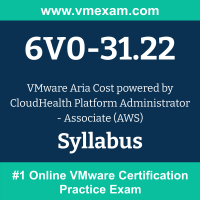 The VMware 6V0-31.22 exam preparation guide is designed to provide candidates with necessary information about the CloudHealth Platform Administrator exam. It includes exam summary, sample questions, practice test, objectives and ways to interpret the exam objectives to enable candidates to assess the types of questions-answers that may be asked during the VMware Aria Cost powered by CloudHealth Platform (AWS) Skills 2024 [v2] exam.
The VMware 6V0-31.22 exam preparation guide is designed to provide candidates with necessary information about the CloudHealth Platform Administrator exam. It includes exam summary, sample questions, practice test, objectives and ways to interpret the exam objectives to enable candidates to assess the types of questions-answers that may be asked during the VMware Aria Cost powered by CloudHealth Platform (AWS) Skills 2024 [v2] exam.
It is recommended for all the candidates to refer the 6V0-31.22 objectives and sample questions provided in this preparation guide. The VMware CloudHealth Platform Administrator certification is mainly targeted to the candidates who want to build their career in Cloud Management and Automation domain and demonstrate their expertise. We suggest you to use practice exam listed in this cert guide to get used to with exam environment and identify the knowledge areas where you need more work prior to taking the actual VMware Aria Cost powered by CloudHealth Platform Administrator - Associate (AWS) exam.
VMware 6V0-31.22 Exam Summary:
|
Exam Name
|
VMware Aria Cost powered by CloudHealth Platform Administrator - Associate (AWS) |
| Exam Code | 6V0-31.22 |
| Exam Price | $250 USD |
| Duration | 90 minutes |
| Number of Questions | 50 |
| Passing Score | 300 / 500 |
| Recommended Training / Books | Intro to the CloudHealth Platform training (Must be logged into the platform and into CloudHealth Academy for link to work) |
| Schedule Exam | PEARSON VUE |
| Sample Questions | VMware 6V0-31.22 Sample Questions |
| Recommended Practice | VMware Aria Cost powered by CloudHealth Platform (AWS) Skills 2024 [v2] Practice Test |
VMware CloudHealth Platform Administrator Syllabus:
| Section | Objectives | Weight |
|---|---|---|
| Administration |
- Create and manage FlexOrgs including Role Documents, User Groups, and Organizational Units. - Gather data and billing information (e.g., enable integrations, enable SSO, configure accounts and/or Service Principal and Enterprise Agreement) including Reservations.
- Determine the difference in configuration for Standalone, Consolidated, and Linked accounts and their account statuses.
- Configure and manage 3rd party integrations (e.g., New Relic, Datadog, Chef).
- Configure container clusters in the VMware Aria Cost platform and set up/modify container reports. - Understand the types of APIs available and what they are used for. |
20% |
| Reports and Dashboards |
- Differentiate between the available reports and dashboards (e.g., InterActive Reports, FlexReports), manage reports and budgets (e.g., filter, customize, categorize, save, subscribe/unsubscribe, pin/unpin, download), change the dashboard/change the default dashboard.
- Find and analyze information about cost, usage, performance, and security of your infrastructure.
- Determine data sources and ranges in reports. - Describe the concepts of Cost Reallocation and Custom Line Items. |
20% |
| Perspectives Management |
- Build and manage Perspectives including selecting an asset type, choosing a discovery method, merging/cleaning groups, creating Static vs. Dynamic groups, and reducing Assets Not Allocated.
|
20% |
| Optimization |
- Determine appropriate sizing, while ensuring necessary performance. - Analyze use of Reservations and Savings Plans and identify savings opportunities. - Create an RI quote or determine Savings Plan purchasing options. - Optimize non-compute services (e.g., EBS Volumes/Disks, untagged SQL services, disassociated elastic IPs, etc.). - Identify security risks. |
20% |
| Governance and Automation |
- Automations (e.g., enable automations, create an action flow). - Create policies that meet various business scenarios. This includes those that trigger alerts and those that have authorization/ approvers to perform actions. - Exclude resources from policy actions. - Identify missing tags and determine a tagging strategy for your business. |
20% |
